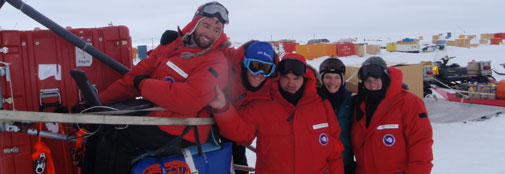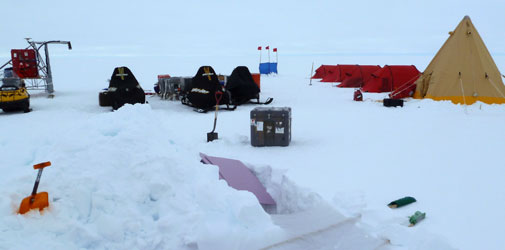Traverse in Antarctica

Michelle Koutnik, guest researcher at the Centre for Ice and Climate, together with the research team, before starting out from Byrd Camp on the 500 km long traverse across interior West Antarctica.
Michelle Koutnik, guest researcher at the Centre for Ice and Climate, has just completed a traverse in Antarctica. From "Down-there" she has sent a short synopsis from her season and a link to the blog which the team kept along the traverse
I just returned from Antarctica working with a team of scientists from NASA, Brigham Young University, and University of Utah. The goal of this work is to understand recent changes in snow accumulation across Central West Antarctic Ice Sheet (WAIS). Mapping the spatial and temporal variations in accumulation rates over the Antarctic ice sheet is essential for understanding ice sheet responses to climate forcing.
Antarctic precipitation rate is projected to increase up to 20% in the coming century and accumulation is a key component for determining ice sheet mass balance, though there are few ground-based studies to measure accumulation variability over the past 50 years. As part of this project we collected radar and ice-core derived annual accumulation datasets that will map recent accumulation trends and provide validation data for satellite remote sensing algorithms.
To collect the data for this study we were on a snow machine traverse across interior West Antarctica. I was part of a similar field expedition last year from November-December 2010. This year we began our traverse at Byrd surface camp, compared to last year when we began at WAIS Divide ice-core camp. We left the US on November 19 but did not get to Byrd camp until December 7 after we prepared our field gear and science equipment at McMurdo station, and after we had good enough weather to fly to the field site. We assembled our sleds and science gear at Byrd camp and over three weeks we traveled by snow machine over 500 km across the ice sheet.
We collected radar data along our entire traverse route, and also conducted specific radar surveys at each camp site. There were six different camp sites and at each site we drilled a 20 meter ice cores and sampled a 2 meter snow pit. The work went very smoothly but we had some delays due to two big storms. We were a 5-person team with a small self-supported camp so it was a big effort to maintain ourselves in storms with 40-50 knot winds – despite the wind and drifting snow we managed very well and felt the extremes of Antarctica.
After the traverse we returned to Byrd camp where we unpacked all of our gear to return to McMurdo, and two from our team went by Twin Otter to pick up our ice-core boxes that had been cached at each camp site. Our ice cores will be transported with the WAIS Divide ice cores. In the end we finished all the work and everything was a success – a huge credit to the entire team!
READ the blog from the traverse

A photo of our camp with the snow pit and adjacent ice-core location. The snow machines and the radar sled are in the background. The radar system is from the Center for Remote Sensing of Ice Sheets (CReSIS) in Kansas.
